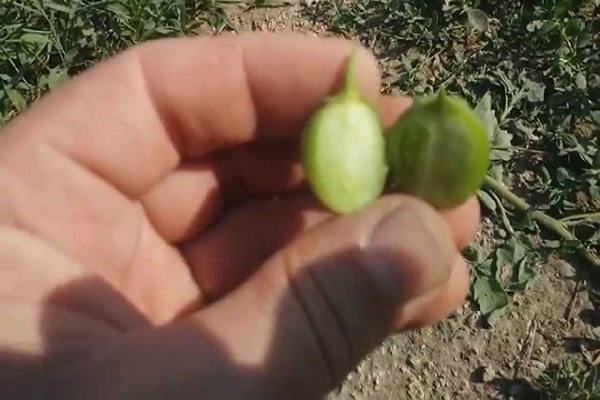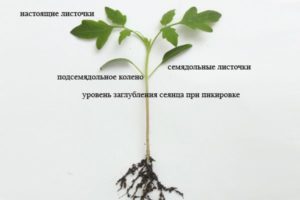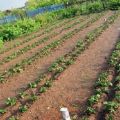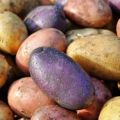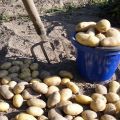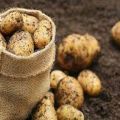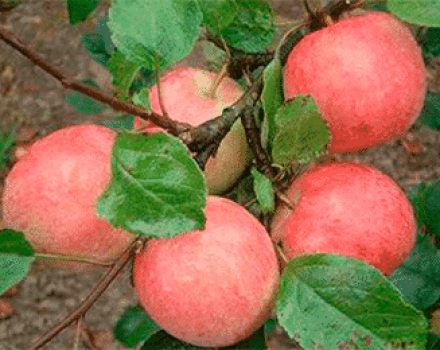Description of the crossed plant variety Pomidofel and its cultivation
To save space in the beds and increase the amount of harvest, breeders are constantly experimenting with crossing different crops. Agronomists from Great Britain and New Zealand jointly invented a hybrid called Pomidofel. The plant has ordinary potato tubers, and instead of tops, tomatoes ripen on the bush.
Description of the variety
The characteristics of any hybrid variety do not allow an accurate description of the plant, since its characteristics depend on the seedlings being crossed. The general properties include the appearance of the plant, which is a bush with leaves of rich green color. Tomatoes growing on bushes can weigh from 300 to 800 g.
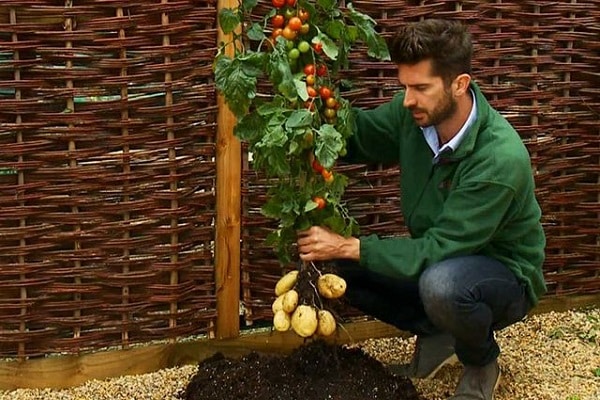
The soil contains potato tubers weighing about 100 g. One seedling of the plant bears 8–12 potato fruits. Indicators of keeping quality, starchiness and condition of the pulp depend on the specific variety used for crossing.
Growing
It is impossible to plant Pomidofel with seeds on the plot, since the hybrid is grown only by grafting. When the stems of potatoes and tomato seedlings reach a thickness of 0.5 cm, grafting can be carried out. The length of the slices should be more than 4 times the thickness of the stems. You need to graft each shoot, making splits on the cuts of the stems, and connecting them with each other, preventing temporary drying. Then the shoots need to be tied at the junction with a bactericidal plaster and left in a dark place for several days.
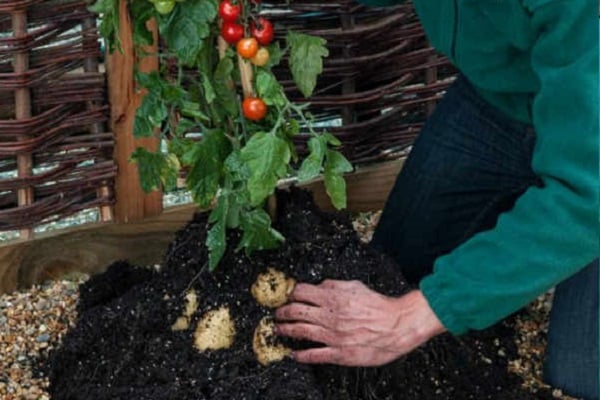
Before planting seedlings, you must first moisten the soil and the plants themselves. 7-9 days after grafting the stems, you need to plant the crop in the ground under the covering material or bags. After another week, you can remove the bandage from the junction of the stems. If the seedlings do not grow well together, you should leave the strapping material for a few more days.
Care features
The bushes of the plant begin to bloom a few days after planting. The first fruits grow in a couple of months. To get a good harvest, you must follow the list of standard rules for crop care. During the growth of the hybrid, it is necessary:
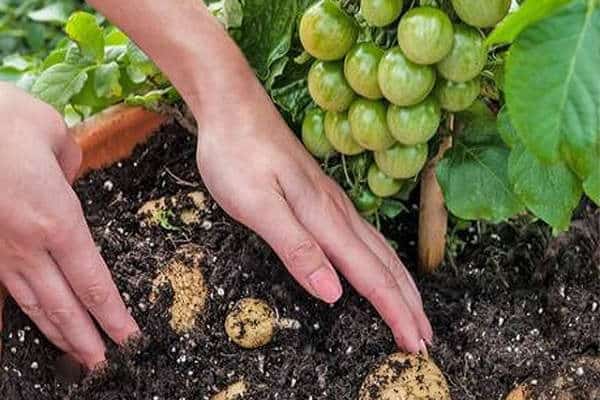
- Loosen the ground periodically.
- Visually inspect the beds and remove any weeds found.
- Water the crop avoiding drought. The frequency and amount of watering depends on the climatic conditions.
- Apply fertilizers suitable for potatoes and tomatoes.
- If rot is found on the leaves of the bushes, treat their surface with disinfecting fertilizers.
When planting a plant in the ground in the spring, you do not need to water it immediately, since the soil will be saturated with moisture.Excessive moisture or stagnant melt water can lead to root rot and seedlings wilting.
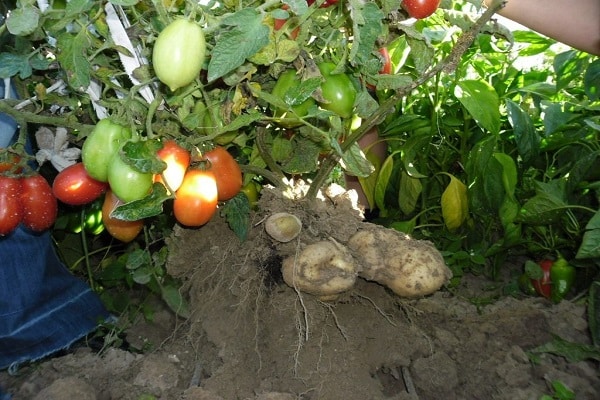
Advantages and disadvantages
Due to the specificity of the plant and the characteristics of cultivation, a number of both pros and cons of a hybrid can be distinguished. The benefits include:
- Saving space at the summer cottage. From each planted bush, you can harvest two crops at once.
- Original. Tomato has not yet become widespread and is an exclusive variety.
- Productivity. Despite the crossing of crops, the quantitative indicator of the yield is not lost during the cultivation process.
- Safety. Vegetables growing on a hybrid plant are subject to long-term storage, which allows you to grow a large number of fruits and leave them for several seasons.
- Benefits and taste. The grown fruits retain their beneficial characteristics, and hybridity has a positive effect on the taste.
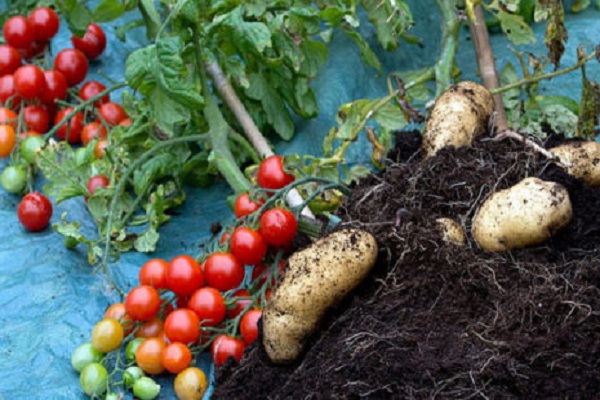
The disadvantages of growing this variety include the following:
- High price. The cost of one seedling is overstated due to the complexity of crossing and the uniqueness of the hybrid.
- Demanding fertilizers. Since the hybrid combines two crops at once, fertilizers will be required for both potatoes and tomatoes.
- Difficulty landing. You can only grow a plant by grafting stems of different varieties.
- Specificity of care. Since fertilizers and nutrients come from the bottom up, it is difficult to evenly distribute the nutrition for the fruit.
Observing all the features of growing this crop, you can get a large harvest that will pay off the costs of plants and nutrients. The fruitfulness of the Pomidofel variety exceeds that of conventional potato and tomato varieties.
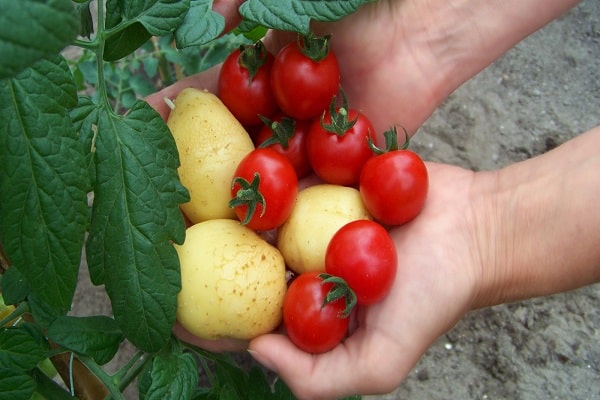
Pests and diseases
When developing a hybrid, breeders feared that the poisonous enzyme corned beef contained in potato tops could negatively affect the tomato fruit. In practice, the content of this component does not exceed the standard.
In addition, the plant is distinguished by its vitality and is not harmed even by the common disease late blight.
The persistent scent of tomatoes scares off the Colorado potato beetle hybrid and similar pests, but if not properly cared for, the plant bushes can infect such insects as aphids, nematodes, spider mites and thrips. Any insecticidal components are suitable to scare off the listed pests. As an additional measure to fertilize and increase fruiting, compost and soil-improving additives can be added to the soil.

Harvesting and storage
The first tomatoes grow on the bushes of the variety a few months after planting. The emergence of young tubers can be tracked independently if the soil is carefully loosened. Experienced gardeners advise harvesting Pomidofelles with the onset of autumn. One plant bush can produce about 3 kg of potatoes and 5-6 kg of tomatoes.
Grown fruits are suitable for long-term storage due to good keeping quality and attractive presentation. You can store vegetables in the refrigerator, drawers, or shelves. The main thing is that the storage has a cool temperature and minimal lighting.
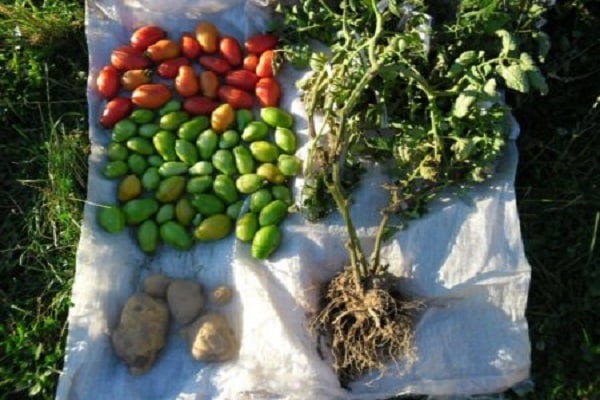
Gardeners reviews
Marina, Tomsk:
“I risked planting Pomidofel in the country, for the experiment I took only a couple of bushes. Surprisingly, the seedlings took root well and gave a large harvest. I will try to plant more hybrids next season. ”
Oksana, Ivanovo:
“I have heard a lot about hybrid varieties, but only came across Pomidofel last year. I would like to note the great profitability of the variety - I have grown several tons of vegetables in a small area. "
